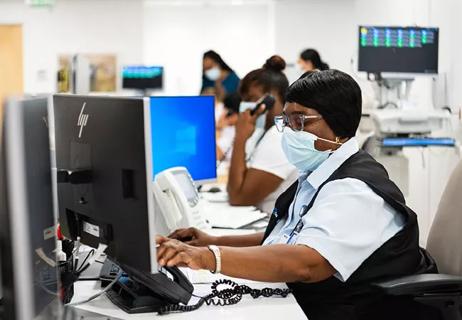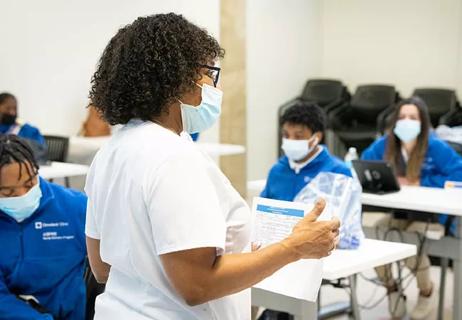Learning the culture and listening come first

Jacqui Robertson, a veteran leader with extensive experience in human resources, diversity and inclusion, has been named Cleveland Clinic’s new Chief of Diversity & Inclusion as of March 1, 2022.
Robertson comes to Cleveland Clinic from William Blair & Co., where she served as Global Head of Talent, Diversity & Inclusion. In her new role, she will lead Cleveland Clinic’s Office of Diversity & Inclusion and report to K. Kelly Hancock, DNP, Chief Caregiver Officer.
Cleveland Clinic is a non-profit academic medical center. Advertising on our site helps support our mission. We do not endorse non-Cleveland Clinic products or services. Policy
Among key areas of focus will be developing strategy and governance for diversity and inclusion (D&I) across the health system, integrating D&I to benefit patients and caregivers, and providing guidance to employee resource groups.
Consult QD caught up with Robertson recently to hear her thoughts on what D&I work means these days and how she plans to approach the task of acclimating to a new workplace culture.
A. When I started speaking with people about this position, I saw that many of my personal values are closely aligned with the values of Cleveland Clinic. I’ve always been an advocate for equitable care. I know from personal experience — family members, friends — that Cleveland Clinic treats patients like they are family, and that deeply resonated with me.
A. A common theme throughout my career has been someone tapping me on the shoulder to ask me to consider a role. It usually has not been something where I say, “Gee, I want to go do that.” I was never like that. Yet these diverse experiences have prepared me for where I am today. Would things have been different if I had been more intentional about every step in my career? Who knows? I don’t think I would have raised my hand for a multi-year assignment in Europe. Apparently, leaders saw something in me that I couldn’t see in myself. I have two sons and one of them has been very intentional about his career. He knows exactly what he wants to do. I love it and envy it at the same time.
A. When I was at Cigna Health Insurance, a mentor tapped me on the shoulder and asked me to be part of Re-Insurance. I had made a comment that everyone in Re-insurance seemed to be the same kind of individual. There was little diversity.
My mentor said “Why don’t you come on board and change this dynamic?” I asked how I would do that. He said “Come on board and create competency models.” I didn’t even know what a competency model was.
Once I learned how to create a competency model, I interviewed some of our key players against the key ask – developing inspirational behaviors to promote. I integrated the findings with performance management, talent management, succession planning and recruitment. That model was integrated to augment hiring, development and retention practices.
I didn’t realize how much that would help me as a diversity and inclusion practitioner, but it did. Integrating competency models was key to creating a sustainable diversity, equity and inclusion strategy. Integrating behaviors of our best performers into a more inclusive performance management model made sense. The best leaders in the organization were also the most inclusive leaders. They naturally created an environment of belonging for all talent.
A. When I was interviewing with [Cleveland Clinic CEO and President] Tom Mihaljevic, he asked me whether I had concerns or questions. I told him my biggest concern was my lack of healthcare experience. I confessed to keeping a writing pad next to my bed on my nightstand. If I can’t sleep, I write down what’s keeping me up, and then it’s released from my brain for the moment and the technique allows me to go back to sleep. What I’d been writing on the pad every night was “I don’t have healthcare experience. How am I going to figure this out?”
Dr. Mihaljevic was so kind. He said “It’s OK that you do not have healthcare experience. We are looking for people with diverse experiences. You will learn. You bring everything else we need.” He recommended a book, Culture Code, by Daniel Coyle. A great read! One of my favorite chapters was on leaders and vulnerability.
While it is true that I don’t have healthcare experience, I’m always willing to admit I don’t know what I don’t know. And I’m always willing to be vulnerable and leverage the collective skills and strengths of others around me. In some organizations, vulnerability is seen as a weakness, but what if vulnerability were viewed as a strength? What if vulnerability were rewarded as a leadership quality? In my mind, vulnerability equals truth. Truth equals trust. Trust is the foundation upon which culture is based.
A. The business case is clear for why we need more diverse backgrounds, people and perspectives as part of our organizations. However, as clear as the case is, there are people who still believe that diversity is a zero sum game. But the evidence supports that organizations with more inclusive leadership are high performing organizations. The challenge is making sure that those proof points are embraced by every person who is in a leadership position, managing talent, hiring talent and promoting talent. They need to be clear on this, not just cognitively, but also in their spirit and in their hearts. Otherwise, it’s too easy for bias to creep in.
And yes, we have programs on training and mitigating bias, but it’s not until it’s in your heart and you recognize it as a value and a game changer that things are going to change. We must constantly challenge ourselves to be fully aligned with Cleveland Clinic values in our hearts, spirit and behaviors.
A. To listen.
I have aspirations to create customized diversity and inclusion plans, but everything that goes into those plans requires that I understand the current state. For the first 90 days, if you’re not listening and absorbing, you will inevitably miss the problems you’re trying to solve. You miss the current contributions and collective intelligence of the organization, and you will fail to distinguish between what’s going well, what needs to be improved, and the challenges to closing these gaps.
One of the most difficult yet critical things you must do when you join an organization is to really understand intimately what that culture is.
When I was living in Amsterdam, I worked in the ING House — a futuristic, modern and beautiful building constructed like a table on 16 angled steel legs. The floors were modern marble. I remember walking down one of the long corridors and you could hear the sound of my heels clicking as I walked. I was pulled aside by the head of HR. She said, “You must do something with the heels on your shoes. We cannot have this noise as you walk down the hallway.”
Now, as much as I had learned about the culture by that point, there was a lesson I had not learned. Was it just the clicking of heels on the marble floor that was the issue, or was there something deeper? Eventually I learned that it meant something deeper. Despite the claim of the “open door policy,” this was a very formal culture. I was also an outsider in many respects — I was American, female and Black. I needed to respect the norms of the culture while learning to navigate it. It was more than annoying them with the clicking of my heels. There, you must be seen and not heard until you are asked to be heard.
A. I went and had little rubber tips put on them.

Community outreach strengthens Cleveland Clinic’s commitment to patient-centered care, building a representative workforce

How to promote equitable and inclusive care

The Black Heritage Employee Resource Group reflects a broader spectrum of caregivers

Re-imagine hiring and growth models

Cleveland Clinic awarded for its efforts

Programs and partnerships focus on community, diverse hiring

Flexibility, support and foundational skills are key

How technology is changing how and whom we hire